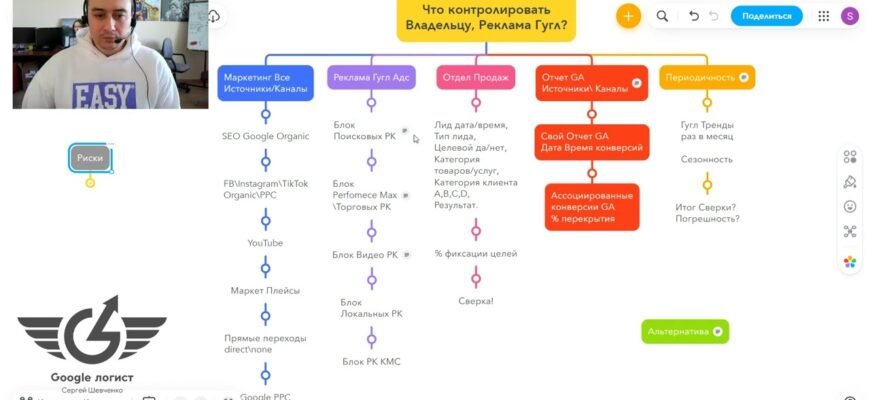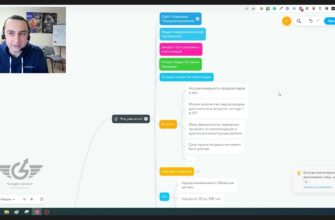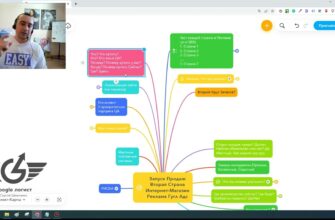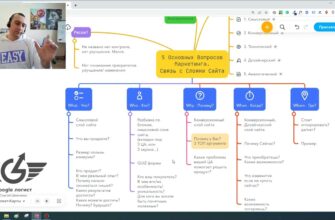- Risks block
- 1. No increase in sales profit in a flat market
- 2. There is no consistency in a flat market
- 3. No flexibility for market fluctuations
- 4. We pay more
- 5. Let’s get less
- Block “Marketing. All sources/channels”
- 1. SEO Google organic promotion
- 2. Facebook\Instagram\Tik-Tok\Organic\PPC
- 3. YouTube blog
- 4. Marketplaces
- 5. Direct transitions direct/none
- 6. Google PPC. Google Ads
- Google Ads block
- 1. Block of search advertising campaigns
- 1.1 Structure by category
- 1.2. Impression % for hot, queries with identified need, brand-model traffic, geo
- 1.3. Cost of a lead, target lead
- 2. Block Performance Max\Shopping Campaigns
- 3. Block Video advertising campaigns
- 3.1. Selection of the target audience
- 3.2. Reach
- 3.3. Price per view
- 3.4. Assisted Conversions
- 3.5. Time to application
- 4. Block of Local Advertising Campaigns
- 5. Display Network Ad Campaign Block
- Sales department block
- 1. Lead information. Customer categorization
- 2. Target fixation %
- 3. Verification
- Three reports block
- 1. GA report Sources/channels
- 2. Your GA report. Date time conversions
- 3. Google Analytics Assisted Conversions. % overlap
- Periodicity block
- 1. trends. Seasonality
- 2. Verification results. Accuracy
- Alternative
Hello everyone. Today I want to talk on the topic: “What needs to be controlled by a business owner, a marketer in marketing.” Briefly and in detail in Google advertising. Let’s touch on the following blocks in the video. “Risks”, if we do not do this, what risks do we face. There will be a block “Marketing. All sources/channels advertising”. Google Ads. We will reveal in more detail the source, the traffic channel. Separately, what we want to receive is to see from the sales department through the eyes of the Google advertising agency marketing team. 3 reports, in my opinion, are the main ones that should be taken into account and monitored periodically, once a month. With what frequency. Hints and an alternative blog when not needed. In which case the owner does not need to bother with such things, but it is possible to calmly delegate and then return to things in more detail. Okay.
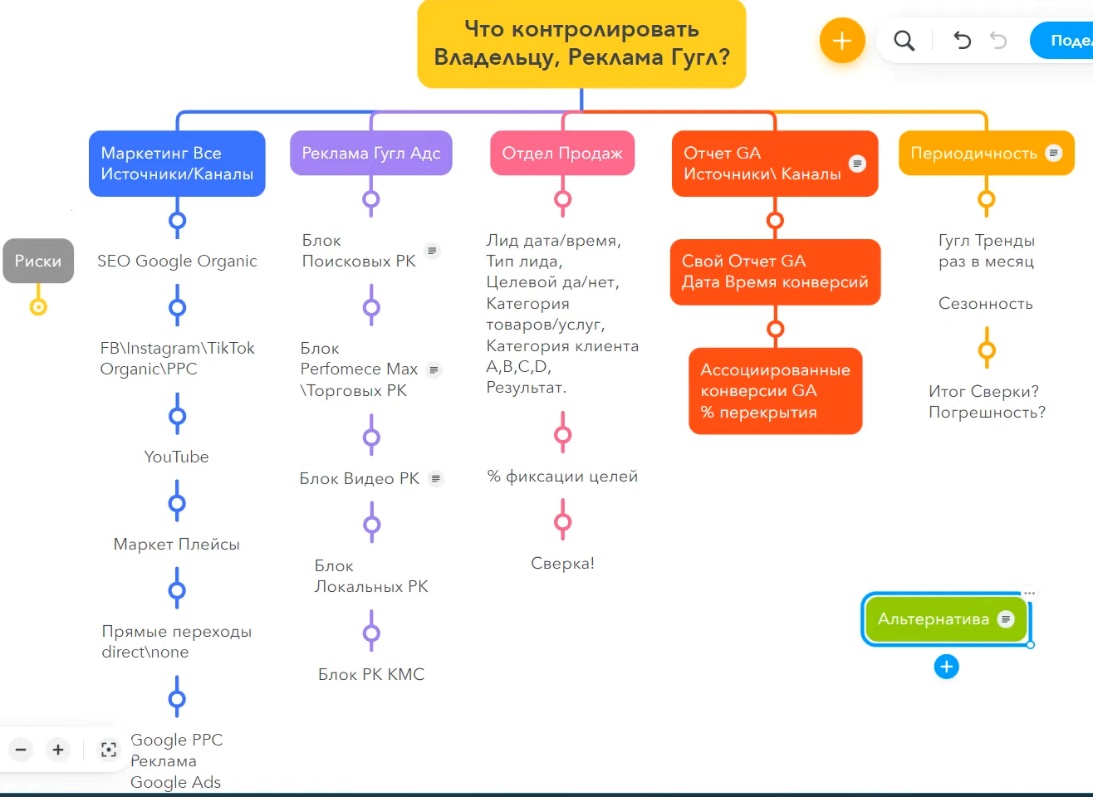
Risks block
1. No increase in sales profit in a flat market
We have risks. The recording is in progress. Risks. No profit growth. We do not understand not only the result, how much money we invested and how much we received. Intermediate blocks are broken – there is no answer, there will be no profit growth, sales growth. The market is flat. Some improvements are making chaotic. We do not understand what they lead to.
How many calls and sales will I get by ordering contextual advertising from you?
I need to calculate the conversion of my website Describe
the task
in the application
Calculate potential ad revenue Google
contextual advertising calculator

Everything is blurred in averages, some kind of average indicators between different categories of goods, different types in advertising campaigns, different channels in seasonality in weekly fluctuations in demand. It is not clear, they did something, improved in marketing, website, advertising. It is not clear what this led to.
2. There is no consistency in a flat market
In a flat market, we will not be able to receive a constantly stable number of orders at a stable cost per lead, sale that is profitable for the company. We don’t understand what it consists of, how profitable sales are obtained.
3. No flexibility for market fluctuations
There are fluctuations in the market, so there must be fluctuations in the budget. Plus or minus, there should be a stable profitable price per lead from each category of goods. Yes – we are following the waves of demand, at least in the categories that are hot, “low-hanging apples.” There is a drop in seasonality, sales have decreased, half of the high season, which means that the cost of an advertising company, advertising campaigns, should be half as much. The logic is in this.
4. We pay more
We will pay more for the same result, as the averages in the account will begin to blur. This is not profitable.
5. Let’s get less
We can, it doesn’t have to be at the same time. Perhaps either / or we get less. Risks await, if we do not, the team will not control the blocks.
Block “Marketing. All sources/channels”
The first block is when we talk about all the marketing for the site. Now we are talking about all sales of the site. All sales from the site are interesting through the eyes of a marketer, through the eyes of the Google advertising agency team.

Why? There are offline activities that lead to sales, but they are not interesting without visiting the site. There are offline activities that lead to purchases through visiting the site – they are interesting. There are sales from OLX or from price aggregators without visiting the site or from Facebook – they are not interesting if they participate in the chain. The site is interesting. It is possible to work with him in a basic way. There are exceptions. You can discuss them. This is for the advanced level. Base. Is in the account or not.
1. SEO Google organic promotion
An important source of traffic channel, as there are some people who fundamentally do not click on paid advertising. You can only get them from Google organics. Like 20-30 percent of people. Perhaps other channels try to get them. Through YouTube, banner ads. There is a certain percentage of people. This is important to consider. Ideally, develop as organic and paid advertising in Google, if we are talking about Google.
2. Facebook\Instagram\Tik-Tok\Organic\PPC
Separate Facebook, Instagram, Tik-Tok, organic. Possible organic block. Perhaps a block of paid advertising. They are interesting if a site is involved in the chain and they need to be recorded in the sales department. Indicate in this chain that these leads are from such and such a site. If separately Facebook generates leads without visiting the site. There should be a separate list, separate labeling of leads. It is important to understand this.
3. YouTube blog
If YouTube sells, it drives organic traffic. There were orders directly from the YouTube channel. Great. Gorgeous. It needs to be allocated to a separate channel. As a rule, YouTube acts as a powerful channel, the development of trust. Builds trust with the audience and increases the conversion of the landing page. At the first stages of the sales funnel, a larger number of the target audience introduces you. If not, think about what it takes to get started. We will return to the question later.
4. Marketplaces
You sell from marketplaces, Proma, Hotline, other marketplaces and your website participates – a separate block is analyzed separately by the team. See it separately. Why? Talking about Google ads, how many times does it all go to Google ads.
When we launch Google advertising, it is important for the team to understand from 100 sales per month what is on the site, what percentage of sales were from Google advertising. What specific ad sales, what percentage of Google ads, within 30 sales or 50 Google ad sales. What specific sale from which category, from what type of advertising campaigns it came, from what keyword it came. This is a source for increasing efficiency, a source for scaling sales, increasing profits, if we understand, my team understands.
5. Direct transitions direct/none
Direct/none transitions are possible. Terminology taken from Google Analytics, Traffic Sources/Channels report. We will come to him in the red block. 4 block. Direct access to the site. What people? We placed QR codes on offline advertising, there was a sign for a store on an offline point, spoke at a conference, people followed the QR code, simply entered the name of the domain name, went to the site – this is a direct entry to the site. People typed in from memory, they didn’t make a mistake, they entered the name of the domain name in the search engine, they entered.
That’s all – direct visits to the site. As a rule, acquaintances were either offline or online, or others. I saw YouTube ads – then I didn’t click. When a situation happened that your product or service was needed, you just entered the name of the site, you probably switched. More often than not, this comes through Google Organic SEO. Enters the name of the company. The first link of the site is knocked out. Moves there. There will no longer be a direct/none direct entry, but Google organic SEO.
6. Google PPC. Google Ads
And of course Google advertising, Google Ads, Google PPC. In the next block, we will consider it in more detail. What can an owner control in a Google Ads ad? Self leads or has a specialist hired by a freelancer or specialist in a team, or hired by the Google advertising agency. What needs to be controlled in the block? I would like any owner to understand whether the team did everything to pick up low-hanging apples, the hottest traffic at a bargain price, not for business. They took it all from the market, approached to take the maximum possible amount of such hot traffic from the market. Another question. Could my sales department satisfy, as here is the work of the marketer in tandem, the work of the Google advertising team in tandem with the sales department. With feedback. Then you get the best result for a particular project, a particular site, a particular business.
Google Ads block

1. Block of search advertising campaigns
So, we are talking about the hottest traffic, have you done everything? Let’s look at the block of search advertising campaigns first. Blocks of search advertising campaigns – what would you like to see? Through the eyes of the owner, when looking at the structure of the advertising campaign. How were advertising companies created?

1.1 Structure by category
We created one advertising campaign, in which everything was stuffed in a row and some average indicators are not clearly shown. The word screwdriver, they stuffed “buy a screwdriver”, “Kyiv screwdriver”, “Black Decker model M247” and the word “Black Decker” is simple. This is a vinaigrette that will not bring any benefit to the project. He will spend a lot of money, bold words, a brand-model request indicating the model, a specific screwdriver. It will dissolve in requests for information, general requests. Same with the Identified Needs Request.
I would like to see all requests from different types – 4-5 different categories. Therefore, the category structure should be, the names of advertising campaigns should reflect this structure. If the business owner asked “Please give information how much for the last week” or logged into the account himself, uploaded it, screwdrivers were sold. The names of advertising campaigns and in the word in the long name of the advertising campaign screwdriver the word uses an underscore, then Black Decker. Or just “screwdriver” requests for screwdrivers. For screwdrivers, all information can be pulled out by the category of screwdrivers and get an answer to the question.
If everything is glued together in one advertising campaign, then the owner will not be able to receive such a response. A little, ten times more time, to analyze those queries. Moreover, Google hides some of the search queries when it shows statistics.
We divide it into different advertising companies and we get 15 advertising campaigns, 5 for screwdrivers: “Black Decker screwdrivers”, “Makita screwdrivers”, some other, some 5 running brands.
In this form, there will be a search, then in the search we enter “screwdrivers”. 5 companies will be knocked out. In addition to the query “screwdrivers”, there should be a breakdown into brand-model, hotter queries, queries with an identified need, when they say: “We need a screwdriver with a backlight”, for example. There is a specific request with an identified need. As a rule, we understand that such a screwdriver is more expensive than a regular simple one without illumination. This is a bell.
Or “corner fireplace insert”. We understand that if a corner firebox is more expensive, since the glass is corner and design and beauty are more important to the client than just heating the room. If you are interested in being there, you must compete for the request and pay more to get into the top.
The structure, first of all, search blocks, should be convenient so that the owner can quickly find or a marketing analyst find any information by information sections.
1.2. Impression % for hot, queries with identified need, brand-model traffic, geo
The next block is the percentage of received impressions for hot keywords. When we have prepared the structure of the advertising account, there will be hot keywords, advertising campaigns, specific names of advertising campaigns. For example, 15 advertising campaigns have been uploaded. Of these, 5 are hot, brand-model queries, or queries indicating geo, or with an identified need, some general information queries, or queries with errors. We can even exclude them at the initial stages and not spend money on them. It is important, if the project is being launched at the start, to be tested, to make it profitable for the business to receive sales precisely from hot requests, so that first of all the site can be taught to sell profitably and get an average conversion in the market for these requests. Then it is possible to move on.
1.3. Cost of a lead, target lead
It is also important to understand the cost of a lead and the cost of a target lead in the context of these advertising campaigns.
2. Block Performance Max\Shopping Campaigns
The next block is the block of Performance Max and trade advertising campaigns. Of course, it is paramount in the first place, and it is worth starting with it, as the cheapest source of getting cheap sales from the market. Performance Max can compete with trade advertising campaigns, theoretically only Facebook can act, and even then not for all categories. There are categories in which only Performance Max and a trade advertising campaign will work. There used to be Google shopping, which worked great. Now his algorithms have been partially transferred to Performance Max. It has been further expanded.
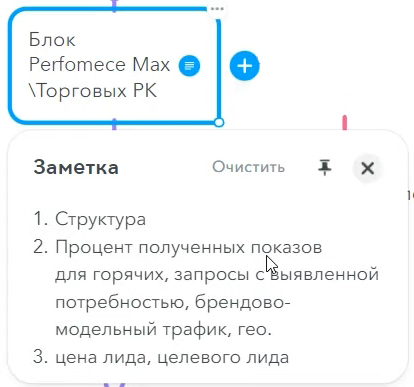
We recommend that you continue to use already quite old shopping advertising campaigns, combine their use simultaneously with Performance Max. You need to understand the strengths of both trading and Performance Max. It is important for the owner to understand that advertising campaigns are loaded. That team, the person who accompanies, understands the strengths of Performance Max and trade advertising campaigns, combines the use, tests different strategies within these advertising campaigns in different periods of the month of weekly fluctuations. And ideally, in a boosted advertising account, when the project receives 100 sales per month of the Google advertising campaign, the Performance Max block and sales results in 40 to 60 percent of all sales for the online store.
These sales are the cheapest. In the search will be the same or more expensive. In other advertising campaigns will be more expensive. Everything that is hot you need to squeeze out and, first of all, teach the site to sell from these advertising campaigns. Performance Max for industrial businesses that are engaged in B2B sales, they can be used to sell services. Might need to be used. The team must understand how it works and use the strengths of Performance Max, because it works partly in search and partly as a display ad. As a rule, it works better than display banner ads. It is important to understand, and in terms of importance, the second block of advertising campaigns is this one.
3. Block Video advertising campaigns
Another important block for the owner is video advertising. What is important to understand? In a good way there should be videos. 70 percent of businesses don’t have videos like this. If you create 10-15 short videos, where you tell, give an answer to questions. 18, 20 Essential Questions Sales Department Answers Every Day. The owner himself will write down the answers to questions, tell people.

3.1. Selection of the target audience
For example, for different portraits of the target audience. There are three priority portraits of the target audience. In their language, explain why the product category is appropriate. How to choose? What to look for when choosing? What to consider? When Google ads are launched, video ads in video, you can start by serial video display, where the second video is shown to the audience of everyone who has watched the first one. The third video will be shown to the audience by everyone who watched the first and second. Up to 5 attachments are possible to make this chain. This is how the user is stretched at each stage of the sales funnel to the next, before the sale.
Already bought, it is possible to offer arguments for resale in a further chain or for a recommendation to friends and acquaintances.
3.2. Reach
Look at the reach of what was in the block of the advertising campaign. How has the video ad block changed since last month?
3.3. Price per view
What is the cost per view? Usually the cheapest when talking about attracting a new audience or introducing a warm audience to a product and turning it from warm to hot, then video is a cool tool. Allows for two or four cents for the Ukrainian market to get… In the US, depending on the niche, the price may be more expensive than 10, 15, 20 cents. It can reach up to 40 percent per view. How narrow the audience you choose depends on how solvent it is.
We fight for the attention of the audience with other advertisers that are willing to pay. If, relatively speaking, we are fighting for an audience that can potentially buy some kind of sailing yachts and wants to park them somewhere in the Florida area – one story. Fighting to sell cheap bikes is another story. Although an inexpensive bike can be bought by a person who has seen expensive yachts. Here you need to consider.
3.4. Assisted Conversions
Associated video conversions are unlikely to depend on video, audience, product. Direct sales with video is not a fact that you will immediately receive. You can influence the increase in associated conversions from blocks of search advertising campaigns, top blocks and Performance Max. We advertised the video of the company, learned about the company, learned about the solutions that you offer, saw the reviews, saw the cases, how it was implemented. Then, as a result, they left an application through search advertising or shopping advertising campaigns.
3.5. Time to application
It is important to consider the time needed before the application. The time before the application of video advertising is possible longer. What is the output? With relatively small amounts of 100, 200 dollars a month, we can simply stretch the test of video advertising campaigns for a longer period. In the search, it can be seen in a week: it works, it does not work. In a video, it may take 3 weeks, 6 weeks to understand how the audience likes it. Do we see a response from investments to real orders. We take into account associated conversions, take into account the time to the application. Perhaps several times longer than the usual time. What is important is the time to the application from the first touch of the user with the company, with the video. One story is a period of time when a person called and then ordered a day, a week, a month, six months later. This is one of the time periods.
The second period. Remarketing may have an effect. The sales department can help. There may be some action here. Some other factors may also affect.
How many calls and sales will I get by ordering contextual advertising from you?
I need to calculate the conversion of my website Describe
the task
in the application
Calculate potential ad revenue Google
contextual advertising calculator
There is a user’s first touch with the site and the time before they call you. Time may vary. For a block of video ads, people who came to the site after watching video ads will definitely take longer than blocks of search advertising campaigns and Performance Max.
4. Block of Local Advertising Campaigns
Let’s move on. Still talking about Google ad block. The next block is a local advertising campaign for a local business. To attract people from your areas on the map so that they come to you more fun. Great for local businesses. I recommend using. Make sure Google My Business is linked to your Google Ads account. Check that the team populates the Google My Business account with company information.
Maybe even some 3-5 percent, 10 percent of leads can be obtained simply from Google advertising. Well, reviews, as a separate story. In Google, my business is to sharpen the sales department, or create a separate department if there are large volumes to receive such reviews.
5. Display Network Ad Campaign Block
The next block is a block of advertising campaigns for the display network. Cool tool. The question is at what stage. Is it necessary at first start? Probably not. If you understand the portraits of the target audience. We talked about them in the video block – you launch them for them, allocate up to 10 percent of the budget from the entire advertising account to the tool block. With the advent of Performance Max, some of the hot customers were taken over by Performance Max algorithms. This tool can and should be used. You understand the portraits of the target audience – deliver messages consistently for promotions, for some things. Cool tool. Do not neglect them.
The question is at what stage, if the project is already developed, and talk about … Not just about collecting demand to meet demand, which already exists without you. We talk about shaping and pushing people to the next stage of the sales funnel, then video and a block of advertising campaigns of the display network.
Sales department block
Another important block is the sales department. Everything that marketers and Google advertising do, the user on the site, can fall apart on a non-working sales department. Or the sales department, where leads are drowning in a quagmire. The feedback from the sales department is unclear.

1. Lead information. Customer categorization
To prevent this, what do you need to understand? The block is the first in importance, no less important than quality traffic to the site. High-quality advertising is the ability of the sales department not only to process and sell, but also to enter this information. Without this, as you will repeat, you scale the result, do not understand the result, did not calculate and did nothing with it, did not categorize it. The simplest CRM is perhaps just a notepad with a pen, an Excel spreadsheet, Google Docs available to everyone. A good tool if there is amoCRM, or now most are switching to others. It doesn’t matter what CRM system you use. The main essence of the CRM-system is the preservation of information in it. The simplest is a Google spreadsheet that the entire team has access to. Reserved once a week, once a month. The simplest tool. What should be?
1.1. Date and time of the lead
Lead information: date and time of the lead, type of lead: this is a call to the head of the manager through Ringtostat’s dynamic call tracking, through ordering a return application to the site. Perhaps by call tracking Ringtostat, Binotel, some other company.
1.2 Lead type
The type of lead is a letter to the mail, which is difficult to track. The letter was through the site form with attached documents – we track it through Google analytics. What type of lead was it? A call to the head of the manager, a callback order, a quick order, an order to the classic basket, a Quiz-form. What type of lead was it. Everything is perfectly set up. Everything is seen. Accuracy. We want to see how the result is up to 80-90 percent. Good accuracy is average for the market. Great.
1.2. Target lead?
Is this the target lead? next item. The sales department enters the information of the target yes or no. Maybe he’s a trash lead. Grandma called to ask if there was washing powder. Never sold powder. Is it possible. Need to fix, then analyze where did you come from? From Facebook, Google display advertising or some other advertising companies, the person may have made a mistake, or this is a lead from dynamic call tracking. Often, in the selection of numbers, those numbers are included that were previously encountered in dynamic call tracking from other companies. Is it possible. Must understand. In this case, just ask to change the company. The number in dynamic call tracking to the new one, so that there is no loop of old orders from the old company, whose number used to be.
1.3. Indication of the category of goods/services
There should be information on the category of goods, services in which the buyer was interested. It is necessary to distribute money more efficiently between categories. We remember that the structure of advertising campaigns was created correctly. We can at any time find by suffixes, prefixes, roots of campaign names what it belongs to. To screwdrivers or geo in Kyiv, or some other requests. We can determine the hotness of traffic by the name of a company in a similar category.
1.4. Client Category
Another block is the client category. As a rule, in 90 percent of cases, after the first communication, the sales department needs up to 5 minutes, 3-5 minutes, after asking 5-10 basic questions, the sales department already understands which category of customers it belongs to. What categories of clients do we recommend to use: A, B, C, D.
Where Category A is a hot, fat client with money. Orders for a good amount, a large one. Ready to pay now. Such clients, as a rule, are 10 percent of the market. Rarely 20 percent.
Category B – the core of the main clients with money. They do not understand why pay now, they were interested in the topic. You need to give an argument. This is where the sales department comes into play. They know how to bring category B customers to a sale. Give arguments to pack, make a commercial offer so that they want to buy, find the answer “Why buy now”, and not postpone for six months and then maybe buy from someone else.
Category C clients. Clients you don’t want to work with. Interested in the category of goods, services. Got to the address. Now there is no money and you yourself do not understand. It takes longer to work with him. Maybe there is money, but it does not fit in terms of values or some other things. It will take longer to work with him when the project is not ready. not interested. 10 percent, 15 percent, maybe 20 percent of such clients.
Category D. Clearly untargeted, garbage leads that made a mistake. Some false positives. Picked up, the phone is silent, does not answer. We set category D – non-target.
The breakdown goes to all leads into A, B, C, D. We see and record the result. “Think”, “sold the meeting”, “departure there”. “We sold the meeting” is already one of the intermediate goals, if the installation of windows and the meeting were sold, it froze. Great goal. No one will buy windows right away, you need to freeze, miscalculate. Further, a proposal for the installation of windows is possible. In this case, the phone, managers sell the measurer’s departure, if the audience is categorized and everything fits, the measurer goes. There is a result of working with a lead. “Refused” is also the result.
1.5. Results of fixing leads
There is information, then it is possible to pull it out at any time for a week, for a day, for a specific lead, the date and time are fixed. Now let’s talk about why a specific date and time. Why shouldn’t it differ from reality, from the fact by more than a minute.
Basic information in the CRM system and in the lead table. Allows you to do magic things further when analyzing periods: a week, a month, a quarter and make changes that significantly increase the effectiveness of advertising campaigns.
What do we see at the output? When they kept this lead table or there is a CRM system now, it doesn’t matter what it’s called. They changed the Russian old one to some now European CRM systems, then spend a month, duplicate the entry of the lead table. Takes 1 minute per lead. 10 leads per day – the sales team will spend only 10 minutes longer. Get invaluable information. You will begin to understand that Google Analytics is deceiving you. Deceives, then in each category of goods by what percentage. You will begin to lay this error in the goals of the Google advertising team, the goals of the Facebook team, Tik Tok. You will begin to understand what kind of error is 20 percent, 10, 15, 50 percent.
2. Target fixation %
At the end, we understand in the sales department what percentage of fixing goals with reality does not match. What percentage of goal fixation matches what Google analytics says for the site.
3. Verification
The important thing is reconciliation. In order for the reconciliation to be carried out, we are just starting, starting work on the project, or something went wrong, some changes were made to the site or the site was redesigned in a new way, goals were entered, the purchase tag was entered. It is desirable to check all pieces for understanding one month. Well, then we will stop this reconciliation and will not waste time, we will use the old CRM system. We understand the actual information to what extent the analyst is lying, not lying. This is a fulcrum based not on pink ponies, but on the real performance of the sales team. In money, in price in each category of goods.
A cool tool. Without a tool, we do not start working with new clients. It is important to conduct this reconciliation of Google Analytics reports. Now let’s talk about which ones. What is the result of the sales department. Any team can market based on this data. You don’t need to communicate with each other. Everyone sees 90 percent. They see the necessary information in the lead table and understand how different it is from CRM, it does not differ.
Three reports block
The next block is three reports. I would recommend that business owners understand, ask, talk about reports, indicators, dynamics from reports.

1. GA report Sources/channels
The first report is, of course, the main report, the base one, in Google Analytics. These are “Traffic sources/channels”. In the report, the business sees two channels on Google: organic, as mentioned in the first paragraph. Organic and paid PPC advertising. both. Well, everyone else goes. As a rule, Google takes more than 90 percent of the traffic on the site together. Each project has different metrics. Here it is possible Facebook, borrow. Sell clothes well Facebook can sell clothes better than Google.
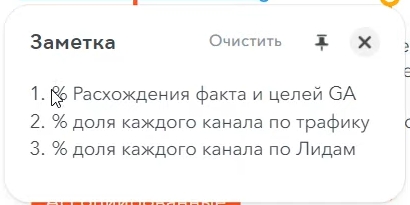
1.1. % discrepancy between fact and GA goals
See in the “Traffic sources/channels” report. What percentage is coming from where. You can understand what percentage of the discrepancy between the fact and the goals in Google Analytics. In the lead table that the CRM system maintains, there is a number of leads per week, see how many goals are triggered in Google Analytics, which goals, and see what percentage they diverge. They differ, but it is desirable that they differ by up to 5 percent, up to 10. If more – guard. We need to look for the reason why this is happening. We recall that it was not just that they kept information about the type of lead. When they said the type of lead, the sales department recorded a call to the head of the manager incoming through dynamic call tracking, a request for a callback. These are different targets in the Traffic Sources/Channels report. They are different and you can compare them. Then the team will be able to verify, and you, as the owner, must ask tricky questions to the team on a specific lead, how the team sees where it came from. When you have descended to the level of a specific lead, specific days, summary – you understand that after providing information at the level of a month / quarter, you can believe with a probability of 80 percent. All. Otherwise…
The key leitmotif of the video is that the owner needs to understand the degree of trust in information shared by projects. Google advertising – such indicators for the month, on Facebook – respectively, such, on YouTube – such, marketplaces – such. How much they lie, they do not lie. What an overlap. Now let’s get to the report.
1.2. % share of each channel by traffic
Following from “Traffic Sources/Channel”. You understand the percentage, the share of each channel in terms of traffic. Traffic is not money. Leads or specific indicators of e-commerce income in an online store are closer to money. You can separately see what percentage of which Google, organic, paid advertising brings more people from Facebook or YouTube to the site and separately sort by the conversion column. There will be different options when it comes to the question of wanting to increase in the next month. Look at the traffic – more leads YouTube to the site.
1.3. % share of each channel by leads
Google search ads lead more by leads. Closer to sales, to real money. The issue of scaling might be worth starting with Google search ads first. View in sections separately traffic, accents. Who are the top three in the sources of traffic channels. Who is the top three in terms of leads or income, if you record a lead in an online store, you have set up analytics in the services.
2. Your GA report. Date time conversions
Second report “Custom report” by date and time of conversions. Ask the marketer to make a report where you can display the source of the channel: Google organic, Google CPC, etc. What day of the month is the 27th. What time was it, 15 hours. What minute, 38. See the table of leads. Let’s say 39 minutes. The incoming lead is fixed, they left a request, the team submitted it. Divergence is possible no more than a minute. The form on the site is filled, at this time the application appeared. Ask the marketer to make a report broken down to the minute.

I understand that there is a CRM system and everything is perfectly recorded. Should at the beginning of the project, for example, return to the question once every six months and exactly after the redesign of the site. To understand to real indicators than what the CRM system sees. We must check and give an answer to the team as far as we can believe.
3. Google Analytics Assisted Conversions. % overlap
The next report is Google Analytics Assisted Conversions. Gives an answer between sources of traffic channels what kind of overlap. At the same time, you order advertising on Facebook, Tik Tok, Instagram, pay for organic SEO promotion. Develop Google ads, account, all channels. Want to understand what overlap is between them.
View, watch once a month. No need to look at the report every day. It is enough to watch once a month, a quarter, to see the dynamics of associating Google Analytics conversions. Especially when you launch a video, see how it affected/didn’t affect other traffic channels, you will begin to understand that the money invested is direct conversions from Google ads. The person came in and Google ads when the person left, but then came to you from organic. The direct lead was assigned to organics, but the associated conversion in the chain was also a Google ad. You understand that you need more than one to one direct leads from each source of the traffic channel. There is an overlap of money that was invested in Google ads and then people caught up with other sources of traffic channels. That’s all for this thing.
Periodicity block
The next block. We are finishing. Periodicity. How often should this be done? If, at the beginning of the project launch, there was a significant reworking of the goals on the site or changes to the site, a new version of the site was introduced, then for the first time to do daily, every day the team will check the short information, allocate 10-20 minutes of time to record the data with accuracy that suits. There is a date, time of the lead. Coincides, does not match why with the CRM system. In Google analytics, information on the site, a letter from the site platform to the mail managers. Possible discrepancy up to a minute. More – you need to understand the reason. The first week will become the basis for the accuracy of fixing information, what will be provided further for the month, quarter, six months, year.

After the first week, for example, the accuracy is 80, 90 percent. See more weekly. The first month, the next four weeks, look at this information weekly, ask a question, ask, kick anyone you need, understand. The basis for further management decisions within the company where to scale first. Where do we get fat clients from, where do they come in easier, with which clients there is less trouble, with which more. Already the sales department will say weekly the first month about it. Then monthly will be enough for the owner.

1. trends. Seasonality
The next block. I would recommend not only to talk about the fact of what happened, but to prepare the team for the future. The owner, along with the marketer, look at Google trends. Once every 1-3 months, look at Google trends, predict what awaits, prepare some promotions.
Especially for new projects that haven’t gone through before. There were no sales, since Google Trends has been taking statistics for the past five years and predicting seasonality. If seasonality subsides, you may want to prepare for it. Prepare either a promotion, or you want to warn the team: a drop in demand will begin, work to make the fall cheaper accordingly. The same amount was paid for the target lead, but the total amount should be less. Well, objectively, there will be fewer sales. Everyone was warned about everything. The team understands what to prepare for. Or you can think of some preventive measures. Think with the team how to sell more now. Since modest sales months are ahead.
2. Verification results. Accuracy
The most important point from what was said, as a result of reconciliation and error, what the marketing team gives out, they understood that, as a result, they can believe the indicators by 80 percent, 90 percent. Great. We understand, we fix. Then we don’t waste time fixing the lead table. We use our CRM system just these indicators, we take into account the error.
Alternative
When is it not needed? What’s the alternative? Businesses have a great “why buy from you” argument. What could be examples. Youtube channel, the owner talks about his company and values. There is a blog, a community, a telegram channel. The project is now up for sale. You can delegate to a marketer. Everything is fine.


